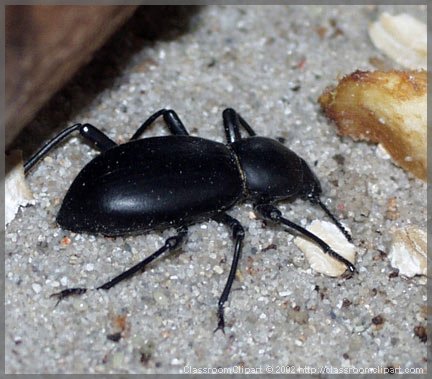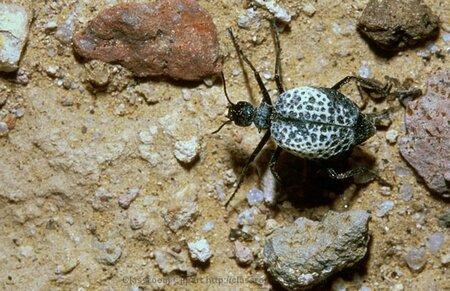Beetle
|
|
| Beetles | ||||||||||||||
|---|---|---|---|---|---|---|---|---|---|---|---|---|---|---|
| Scientific classification | ||||||||||||||
|
Beetles (order Coleoptera) Beetles, belonging to the order Coleoptera, are one of the most diverse and widespread groups of insects on Earth. With over 350,000 known species, they represent about 40% of all known insects and 25% of all known animal life-forms. Their success and diversity make them a fascinating subject in the study of entomology and ecology. Introduction
Coleoptera, the scientific name for beetles, means "sheathed wing," which aptly describes their most notable feature: a pair of hardened forewings, known as elytra. These elytra cover the delicate flight wings and protect the beetle's body. Beetles come in an astonishing variety of shapes, sizes, and colors, adapted to thrive in an extensive range of environments.
| Contents |
Physical Description
Beetles range in size from the minuscule featherwing beetles, which can be less than 1 mm long, to the gigantic Hercules beetles, which can reach lengths of up to 17 cm including their horns. Their bodies are typically divided into three sections: the head, thorax, and abdomen. Beetles have well-developed antennae and mandibles. Their coloration varies widely, from drab browns and blacks to striking iridescent hues.
Habitat and Distribution
Beetles inhabit nearly every habitat on Earth, including freshwater and coastal habitats, forests, meadows, deserts, and even polar regions. Their adaptability to diverse climates and environments is unparalleled in the insect world. Some species are expert burrowers, while others are adept at swimming or flying.
Diet and Feeding
Beetles exhibit a vast range of feeding habits. Some species are herbivores, feeding on plants, while others are predators, scavengers, or decomposers. Certain species, like the bark beetles, can be pests to forests, while dung beetles play crucial roles in nutrient cycling by breaking down animal feces.
Reproduction and Lifecycle
Beetles undergo complete metamorphosis, passing through four distinct stages of development: egg, larva, pupa, and adult. Female beetles lay eggs in carefully chosen locations that offer optimal conditions for larval survival. Beetle larvae, often referred to as grubs, usually have a different diet and habitat from adults. After reaching a certain size, larvae enter the pupal stage, during which they undergo a significant transformation into their adult form.
Behavior and Social Structure
While most beetles lead solitary lives, some species exhibit interesting social behaviors. For instance, some dung beetles roll dung into balls, which are used as food or breeding chambers. Fireflies, a type of beetle, are known for their bioluminescent communication in mating displays.
Conservation Status
The conservation status of beetles varies widely. While many species are abundant, others are threatened by habitat loss, pollution, and climate change. Some, like the American burying beetle, are listed as endangered and are the subject of conservation efforts.
Cultural Significance
Beetles have been symbols in various cultures throughout history. In Ancient Egypt, the scarab beetle was revered as a symbol of creation and rebirth. In popular culture, beetles are often depicted in literature and art, showcasing their enduring influence on human imagination.
Notable types
Well-known types of beetles include:
- bark beetle
- bess beetle
- click beetle
- bombardier beetle
- Colorado potato beetle
- firefly
- ground beetle
- Japanese beetle
- ladybird beetle (or ladybug or lady beetle)
- Mountain Pine Beetle
- scarab beetle
- Spanish fly (actually a beetle)
- stag beetle
- water beetle
- weevil
- Wood-boring beetles (woodworm)
Some types of beetles are less well-known, but are problems in some areas:
Subgroups
The extraordinary number of beetle species poses special problems for classification, with some families consisting of thousands of species and needing further division into subfamilies and tribes.
See Subgroups of the order Coleoptera for a complete list.
Clipart and Animal Pictures
- Clipart (https://classroomclipart.com/image/category/clipart.htm)
- Animal Clipart (https://classroomclipart.com/image/category/animal-clipart.htm)
- Animal Animated Clipart (https://classroomclipart.com/clipart/Animations/Animals.htm)
- Pictures of Animals (https://classroomclipart.com/image/category/animal-photos.htm)
- Amphibian Clip Art, Pictures and Photogaphs (https://classroomclipart.com/image/category/amphibian-clipart.htm)
- Farm Animal Clip Art, Pictures and Photographs (https://classroomclipart.com/image/category/farm-animal-clipart.htm)
- Mammal Clip Art, Pictures and Photographs (https://classroomclipart.com/image/category/mammal-clipart.htm)
- Marine Animal Clip Art, Pictures and Photographs (https://classroomclipart.com/image/category/marine-life-clipart.htm)
- Reptile Clip Art, Pictures and Photographs (https://classroomclipart.com/image/category/reptile-clipart.htm)
- Spider Clip Art, Pictures and Photographs (https://classroomclipart.com/image/category/spider-clipart.htm)



